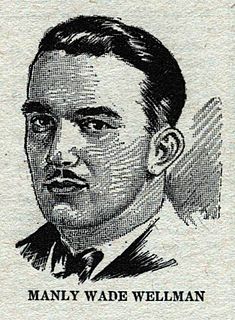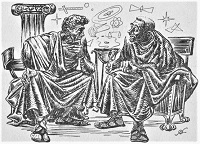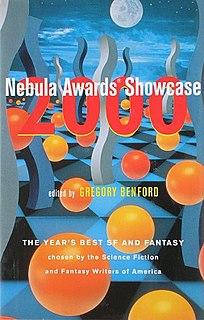
Robert Anson Heinlein was an American science fiction author, aeronautical engineer, and naval officer. Sometimes called the "dean of science fiction writers", he was among the first to emphasize scientific accuracy in his fiction, and was thus a pioneer of the subgenre of hard science fiction. His published works, both fiction and non-fiction, express admiration for competence and emphasize the value of critical thinking. His plots often posed provocative situations which challenged conventional social mores. His work continues to have an influence on the science-fiction genre, and on modern culture more generally.

Ray Douglas Bradbury was an American author and screenwriter. One of the most celebrated 20th-century American writers, he worked in a variety of modes, including fantasy, science fiction, horror, mystery, and realistic fiction.

The Fountains of Paradise is a 1979 science fiction novel by British writer Arthur C. Clarke. Set in the 22nd century, it describes the construction of a space elevator. This "orbital tower" is a giant structure rising from the ground and linking with a satellite in geostationary orbit at the height of approximately 36,000 kilometers. Such a structure would be used to raise payloads to orbit without the expense of using rockets. The novel won both the Hugo and Nebula Awards for Best Novel.

Joe William Haldeman is an American science fiction author. He is best known for his novel The Forever War (1974). That novel and other works, including The Hemingway Hoax (1991) and Forever Peace (1997), have won science fiction awards, including the Hugo Award and Nebula Award. He was awarded the SFWA Grand Master for career achievements. In 2012 he was inducted as a member of the Science Fiction Hall of Fame. Many of Haldeman's works, including his debut novel War Year and his second novel The Forever War, were inspired by his experiences in the Vietnam War. Wounded in combat, he struggled to adjust to civilian life after returning home. From 1983 to 2014, he was a professor teaching writing at the Massachusetts Institute of Technology (MIT).

Robert Charles Wilson is an American-Canadian science fiction author.

Constance Elaine Trimmer Willis, commonly known as Connie Willis, is an American science fiction and fantasy writer. She has won eleven Hugo Awards and seven Nebula Awards for particular works—more major SF awards than any other writer—most recently the "Best Novel" Hugo and Nebula Awards for Blackout/All Clear (2010). She was inducted by the Science Fiction Hall of Fame in 2009 and the Science Fiction Writers of America named her its 28th SFWA Grand Master in 2011.

"The Toynbee Convector" is a science fiction short story by American writer Ray Bradbury. First published in Playboy magazine in 1984, the story was subsequently featured in a 1988 short story collection also titled The Toynbee Convector.

Manly Wade Wellman was an American writer. While his science fiction and fantasy stories appeared in such pulps as Astounding Stories, Startling Stories, Unknown and Strange Stories, Wellman is best remembered as one of the most popular contributors to the legendary Weird Tales, and for his fantasy and horror stories set in the Appalachian Mountains, which draw on the native folklore of that region. Karl Edward Wagner referred to him as "the dean of fantasy writers." Wellman also wrote in a wide variety of other genres, including historical fiction, detective fiction, western fiction, juvenile fiction, and non-fiction.

Teresa Nielsen Hayden is an American science fiction editor, fanzine writer, essayist, and workshop instructor. She is a consulting editor for Tor Books and is well known for her weblog, Making Light. She has also worked for Federated Media Publishing, when in 2007 she was hired to revive the comment section for the blog Boing Boing. Nielsen Hayden has been nominated for Hugo Awards five times.

Green Knowe is a series of six children's novels written by Lucy M. Boston, illustrated by her son Peter Boston, and published from 1954 to 1976. It features a very old house, Green Knowe, based on Boston's home at the time, The Manor in Hemingford Grey, Huntingdonshire, England. In the novels she brings to life the people she imagines might have lived there.

Inside Job is a novella by American writer Connie Willis, originally published in the January 2005 issue of Asimov's Science Fiction and later as a hardback by Subterranean Press. In the story, a debunker of pseudoscience encounters a fake medium who seems to be genuinely channelling the disruptive spirit of H. L. Mencken. It was the winner of the 2006 Hugo Award for Best Novella.

The literary genre of science fiction is diverse, and its exact definition remains a contested question among both scholars and devotees. This lack of consensus is reflected in debates about the genre's history, particularly over determining its exact origins. There are two broad camps of thought, one that identifies the genre's roots in early fantastical works such as the Sumerian Epic of Gilgamesh. A second approach argues that science fiction only became possible sometime between the 17th and early 19th centuries, following the scientific revolution and major discoveries in astronomy, physics, and mathematics.
Timothy Steele is an American poet, who generally writes in meter and rhyme. His early poems, which began appearing in the 1970s in such magazines as Poetry, The Southern Review, and X. J. Kennedy's Counter/Measures, are said to have anticipated and contributed to the revival of traditional verse associated with the New Formalism. He, however, has objected to being called a New Formalist, saying that he doesn't claim to be doing anything technically novel and that Formalism "suggests, among other things, an interest in style rather than substance, whereas I believe that the two are mutually vital in any successful poem." Notwithstanding his reservations about the term, Steele's poetry is more strictly "formal" than the work of most New Formalists in that he rarely uses inexact rhymes or metrical substitutions, and is sparing in his use of enjambment.

Terence William (Terry) Dowling, is an Australian writer and journalist. He writes primarily speculative fiction though he considers himself an "imagier" – one who imagines, a term which liberates his writing from the constraints of specific genres. He has been called "among the best-loved local writers and most-awarded in and out of Australia, a writer who stubbornly hews his own path ."
"Mimsy Were the Borogoves" is a science fiction short story by Lewis Padgett, originally published in the February 1943 issue of Astounding Science Fiction Magazine. It was judged by the Science Fiction Writers of America to be among the best science fiction stories written prior to 1965 and included in the anthology The Science Fiction Hall of Fame, Volume One, 1929–1964. In 2007, it was loosely adapted into a feature-length film titled The Last Mimzy. The title of the original short story was directly inspired by a verse from "Jabberwocky", a poem found in the classic novel Through the Looking-Glass by author Lewis Carroll.

"Aristotle and the Gun" is a time travel and alternate history science fiction story by American writer L. Sprague de Camp.

Julian Comstock: A Story of 22nd-Century America is a dystopian speculative fiction novel written by Robert Charles Wilson, and an expansion of Wilson's 2006 novella Julian: A Christmas Story.
Vintage Season is a science fiction novella by American authors Catherine L. Moore and Henry Kuttner, published under the joint pseudonym "Lawrence O'Donnell" in September, 1946. It has been anthologized many times and was selected for The Science Fiction Hall of Fame, Volume 2A.

Nebula Awards Showcase 2000 is an anthology of science fiction short works edited by Gregory Benford. It was first published in hardcover and trade paperback by Harcourt in April 2000.

Hereafter, and After is a fantasy novella by Richard Parks. It was first published in hardcover and trade paperback by PS Publishing in March 2007. A subsequent ebook edition appeared in October 2011. The print edition includes an introduction by Andy Duncan.

















